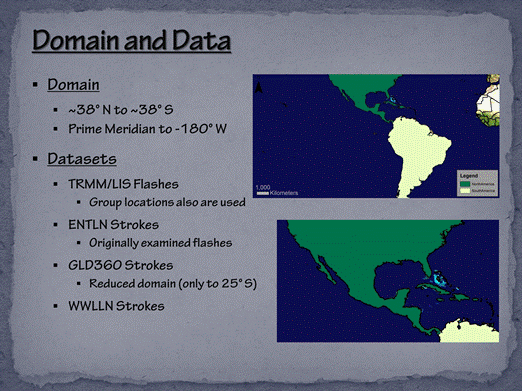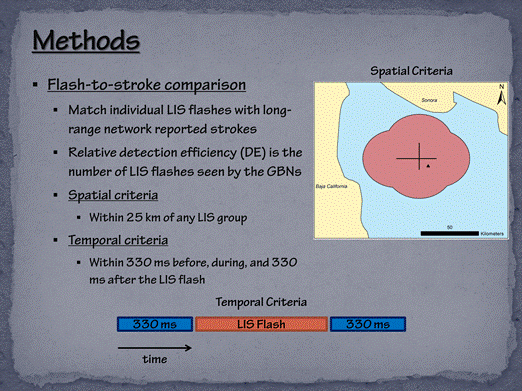|
Our studies match individual LIS flashes and ground-based network (GBN) events to accurately determine the relative flash DE. Direct flash-to-event comparisons also reveal the location and timing differences (offsets) between matched flashes, the number of GBN events associated with each matched LIS flash, and the LIS characteristics (e.g., duration and area) of matched, unmatched, CG, and IC flashes.
Individual LIS flashes are matched with GBN events using the methods described by Rudlosky and Shea (2013). Neither network detects all lightning, but LIS provides the baseline for this analysis. Many time (50 ms to 1 s) and distance (1 km to 100 km) thresholds were examined to determine the best matching criteria. Very tight spatial (1 km) and temporal thresholds (50 ms) reduce the relative DE by roughly half, but outside these tight criteria, reasonable changes to the matching thresholds produced very small differences (less than 5% percent change in DE depending on the sample). We selected distance (25 km) and time (330 ms) thresholds at the broad end of the spectrum to remain consistent with Rudlosky and Shea (2013) and to ensure identification of all matches both inside and outside CONUS (i.e., areas of high and low sensor density). These somewhat liberal matching criteria are narrower than those used by Thompson et al. (2014; 400 ms and 0.15 degrees latitude/longitude), but still require caution to avoid double counting. Geographical Information System (GIS) software also was used to visualize portions of the datasets and ensure proper matching.
LIS flashes are comprised of multiple LIS groups whose times and locations are used to define the spatial and temporal extents of LIS flashes. For LIS flashes to be considered a match, an GBN event must occur within 25 km of any group in a LIS flash (i.e., furthest groups north, south, east, and west) and within 330 ms before, during, or after a LIS flash. Although LIS groups are used to define the beginning, end, and spatial extents of each LIS flash, we report only the fraction of LIS flashes detected by the GBN (i.e., not the fraction of LIS groups or LIS events). Multiple GBN events typically occur during individual matched LIS flashes, and we use the time and location of the first event rather than the nearest in time or space for the time and distance comparisons. The LIS/GBN matches are classified as CG if any of the subsequent GBN events are CG. The relative flash DE is the fraction of all LIS flashes in a region that are detected (matched) by the GBN. Maps of relative flash DE are computed by dividing the sum of the "matched" LIS flashes (i.e., those seen by the GBN) by the sum of "all" LIS flashes within 2x2 degree grid cells. Although important insights can be gained by examining the fraction of GBN flashes seen by LIS, the present study does not investigate this reverse performance metric. The present study also does not directly measure how well the GBN observes the propagation and spatial extent of flashes, only the efficiency at which the GBN detects LIS flashes (i.e., not LIS groups or events).
|






